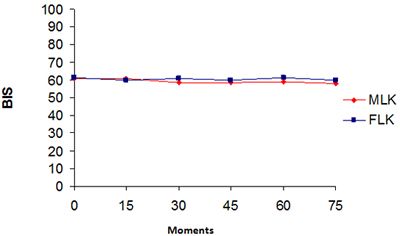Bispectral Index in Dogs Anesthetized with Isoflurane and a Continuous Infusion Rate of Morphine-Lidocaine-Ketamine or Fentanyl-Lidocaine-Ketamine
The aim of this study was to evaluate the effects of morphine-lidocaine-ketamine (MLK) and of fentanyl-lidocaine-ketamine (FLK) association on bispectral index (BIS) in dogs anesthetized with isoflurane that underwent stifle joint surgery.
Two groups (n=8) of dogs, with mean weight of 20.8 ± 3.6 kg were premedicated with levomepromazine (0.5 mg/kg IV). After 10 minutes, anesthesia was induced with propofol (5 mg/kg IV), and the animals were endotracheally intubated and maintained with isoflurane in a semiclosed-circuit under spontaneous ventilation. BIS electrodes were positioned and the dorsal metatarsal artery was catheterized in order to monitor mean arterial pressure (MAP). Once the anesthetic plane was achieved (BIS = 55-65), initial parameters were measured (T0): BIS, cardiac rate (HR), MAP, respiratory rate (f), end-tidal carbon dioxide (EtCO2) and end-tidal isoflurane in V% (EtISO). Right after, MLK (morphine: 3.33 µg/kg/min; lidocaine: 50 µg/kg/min; ketamine: 10 µg/Kg/min) or FLK (fentanyl: 0.033 µg/kg/min; lidocaine: 50 µg/Kg/min; ketamine: 10 µg/Kg/min), both diluted in saline solution, were started at an infusion rate of 10 mL/kg/h.
Parameters were recorded 15 (T15), 30 (T30), 45 (T45), 60 (T60) and 75 (T75) minutes after the beginning of the infusion. Data were evaluated statistically (P < 0,05). HR maintained stable throughout the procedure in both groups; significant differences were seen among groups in T0, T45, T60 and T75, due to individual variability. MAP, f, EtCO2 and BIS values did not change significantly for MLK or FLK at any time point. Both techniques were feasible in maintaining the anesthetic plane, allowing a reduction of 6.25% in EtISO in the MLK group and of 25% in the FLK group in comparison to the EtISO at T0. Considering the measured parameters, MLK and FLK infusion were safe and do not interfere the BIS monitoring (Figure 1).
| Figure 1. | 
Mean BIS values of dogs anesthetized with isoflurane and a continuous rate infusion of morphine-lidocaine-ketamine (MLK) or fentanyl-lidocaine-ketamine (FLK). |
|
| |